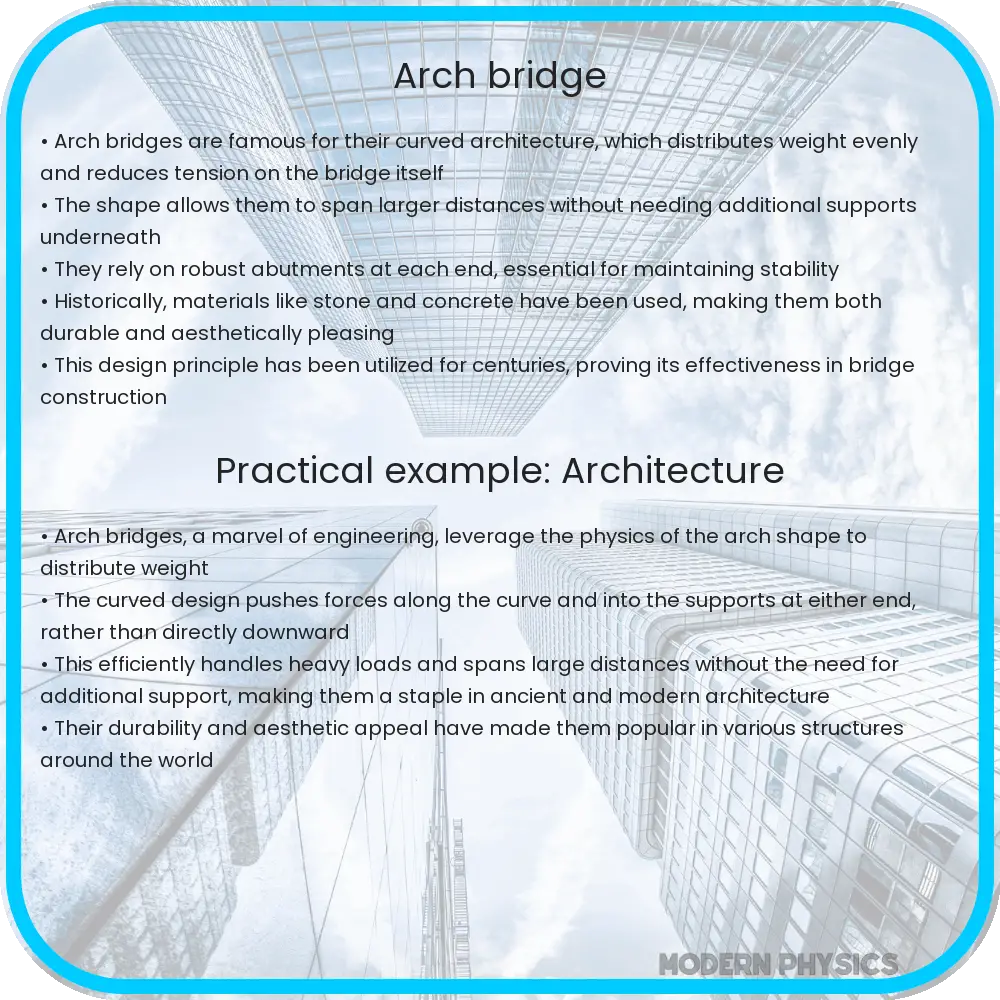Explore the design of arch bridges, covering physics principles, material strengths, dynamics, historical evolution, and modern challenges.

Understanding Arch Bridge Design: Principles of Physics, Strength, and Dynamics
Arch bridges, renowned for their aesthetic appeal and structural efficiency, have been a cornerstone of engineering for centuries. The unique shape of an arch bridge not only provides a distinct visual impact but also offers significant benefits in terms of strength and stability. This article delves into the core principles of physics, strength, and dynamics that govern the design and functionality of arch bridges.
Key Physics Principles in Arch Bridge Construction
The arch bridge design exemplifies the practical application of physics in engineering. The primary principle at work is the transfer of the load. In an arch bridge, the weight of the bridge and its load is carried outward along the curve of the arch to the supports at each end. These supports, called abutments, bear the load and keep the bridge stable. This effective load distribution enables arch bridges to carry heavy loads and span large distances without the need for additional support in the middle.
Materials and Strength Dynamics
The choice of materials plays a pivotal role in the strength and durability of an arch bridge. Traditionally, arch bridges were constructed from stone or brick, but modern engineering has introduced materials like reinforced concrete and steel. These materials offer enhanced strength-to-weight ratios, allowing for longer spans and the ability to withstand higher loads and environmental stresses.
Reinforced concrete, for instance, utilizes the compressive strength of concrete along with the tensile strength of steel. This synergy allows for a more efficient design, reducing material usage while maintaining structural integrity. Steel, known for its high tensile strength and flexibility, is ideal for bridges that require longer spans or are subject to dynamic loads such as heavy traffic or wind forces.
Arch Shape and Load Dynamics
The shape of the arch is critical in determining how effectively it can distribute the load. The most common arch shapes are the semicircular arch, the segmental arch, and the parabolic arch. Each shape has its unique way of handling compressive forces, which are the primary forces acting on an arch bridge.
- Semicircular Arch: Provides a balanced distribution of forces, suitable for shorter spans.
- Segmental Arch: Flatter than a semicircular arch, it can span longer distances but requires precise engineering to handle the resulting horizontal thrust.
- Parabolic Arch: Offers the most efficient load distribution, ideal for long spans and heavy loads. It directs the forces downwards rather than sideways, minimizing the horizontal thrust on the abutments.
The dynamics of load distribution in arch bridges are inherently linked to their geometry. This relationship between shape and strength is a fundamental aspect of arch bridge design, highlighting the importance of meticulous planning and precision in architectural and engineering endeavors.
Impact of Environmental Factors
Environmental factors such as wind, temperature variations, and seismic activity also play a significant role in the design of arch bridges. The structure must be designed to withstand these external forces while maintaining its integrity and safety. This involves detailed analysis and often the incorporation of expansion joints and other features to accommodate movement and stress.
In conclusion, the design of arch bridges is a complex interplay of physics, materials science, and environmental considerations. The next section will explore the historical evolution of arch bridges, modern advancements in their design, and the challenges faced in contemporary arch bridge construction.
Historical Evolution and Modern Advancements in Arch Bridge Design
Arch bridges have a rich history, dating back to ancient civilizations like the Romans, who mastered the art of stone arch bridge construction. Over the centuries, the design and construction techniques have evolved significantly. The advent of modern materials and computational design tools has expanded the possibilities, allowing for more daring designs and longer spans. Contemporary arch bridges often incorporate aerodynamic shapes and utilize advanced materials like high-performance concrete and weathering steel, which offer enhanced durability and lower maintenance requirements.
Challenges in Contemporary Arch Bridge Construction
Despite these advancements, constructing arch bridges presents several challenges. One of the primary concerns is the environmental impact, including the disruption of natural habitats and waterways. Additionally, the construction process itself can be complex and costly, especially for long-span bridges that require extensive scaffolding and temporary supports. Engineers must also consider the long-term maintenance needs and ensure that the bridge can be easily inspected and repaired as needed.
Technological Innovations in Arch Bridge Engineering
Technological innovations continue to shape the field of arch bridge engineering. The use of computer-aided design (CAD) and finite element analysis (FEA) has revolutionized the way bridges are designed and tested. These tools allow engineers to simulate various load conditions and environmental factors, optimizing the bridge design for both efficiency and safety. Moreover, the integration of smart sensors and monitoring systems in bridge structures facilitates real-time health monitoring, helping to predict maintenance needs and prevent structural failures.
Sustainability Considerations
Sustainability is increasingly becoming a focal point in arch bridge design. Engineers strive to minimize the ecological footprint by using locally sourced materials, reducing waste, and implementing energy-efficient construction practices. The longevity and low maintenance requirements of modern arch bridges also contribute to their sustainability, making them a viable option for environmentally conscious infrastructure development.
Conclusion
In summary, the design and construction of arch bridges encompass a remarkable blend of historical knowledge and modern engineering expertise. From the ancient stone arches to the sleek steel structures of today, these bridges are a testament to human ingenuity and the continuous pursuit of advancement in civil engineering. As we look to the future, the focus on sustainable practices, technological innovation, and a deeper understanding of environmental impacts will undoubtedly lead to even more impressive and eco-friendly arch bridge designs.
